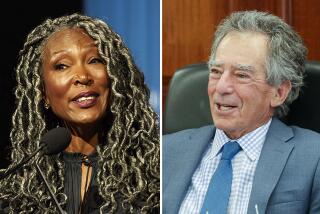Drinks, dinners, favors helped PG&E lobbyist build PUC ties, emails show
- Share via
REPORTING FROM SACRAMENTO — Former Pacific Gas & Electric Co. chief lobbyist Brian Cherry was a master at schmoozing with state regulators.
A can-do political operative, Cherry always had a ready joke or a sympathetic ear for top officials and managers at the California Public Utilities Commission, who oversee just about every aspect of PG&E’s operations — and its bottom line.
All that changed last fall when revelations of Cherry’s persuasive powers set off a scandal over undue PG&E influence at the PUC.
After many complaints about ties between the PUC and the state’s largest utility, PG&E fired Cherry, his boss and another vice president Sept. 15. The utility also released a torrent of documents that has sparked the biggest investigation of a state agency in the last decade.
The documents — tens of thousands of them, including emails between PG&E and regulators — portrayed questionably cozy relations between then-PUC President Michael Peevey and other PUC officials and top utility executives.
Since then, most of the public attention has focused on Peevey, who retired under pressure Dec. 31. His home in La Cañada Flintridge was searched by the California attorney general’s office, working in coordination with the U.S. Department of Justice. In the search warrant, law enforcement agents said they were investigating possible improper communications with regulated companies, bribery and obstruction of justice.
But Cherry also remains a central figure in the probe. His home in the upscale suburb of Orinda east of San Francisco also was searched, using the same warrant served on Peevey’s Southern California residence.
Cherry, critics contend, was a first-rate manipulator, able to quickly contact PUC regulators from Peevey down to the mid-level manager ranks.
“He seemed to have magical powers,” said state Sen. Jerry Hill (D-San Mateo), whose district contains the city of San Bruno, ravaged by the rupture and explosion of a PG&E natural gas pipeline in September 2010. “It was unbelievable how he could get people to talk and break down whatever barriers were supposed to exist between the regulated and the regulator.”
Cherry, 58, spent 14 years as vice president for regulatory affairs at PG&E in San Francisco and 16 years before that in similar jobs with Sempra Energy, the parent company of San Diego Gas & Electric Co. His wife is PG&E’s vice president for investor relations.
A UCLA graduate with an MBA from USC, Cherry was paid more than $500,000 a year in salary and other incentives, according to corporate filings with the Securities and Exchange Commission.
Cherry wrote controversial emails to his bosses recounting informal chats over Pinot Noir and Johnny Walker Blue — a $200 scotch — with Peevey at vacation homes on the Sonoma County coast.
“Cherry’s job was to know everybody and be on good terms with everybody,” said John Geesman, former executive director and member of the California Energy Commission. “You make friends so that your friends could help you.”
Cherry did favors large and small for powerful friends. When Peevey questioned the accuracy of the new PG&E “smart meter” at his North Coast “Sea Ranch” home, Cherry immediately ordered a special audit. When Peevey wondered whether PG&E could do something to bring high-speed Internet to his neighborhood, Cherry had his people look into it.
Along the way, Cherry kept in close contact with his PUC associates and deepened relationships by sending hundreds of often highly personal, bantering and upbeat emails.
In one February 2013 exchange, veteran PUC staffer Michael Colvin wrote to Cherry with news that he had just interviewed for a top job with Michael Picker, a newly named commissioner who this year succeeded Peevey as president. Cherry replied: “I have breakfast with him on Monday. I will put in a good word.”
Cherry generally got a similarly quick response when he needed help from his associates at the PUC. A string of emails released by PG&E showed that PUC officials allowed Cherry to help write a safety directive to PG&E’s president after the utility’s fatal natural gas explosion in San Bruno.
Commissioners and staff assigned a judge whom PG&E liked to a pending natural gas transmission case, and gave the utility back-channel access to key decision makers at the commission on a range of crucial issues.
Cherry was exceedingly effective, said Robert McCullough, a Portland, Ore., energy consultant and expert witness in the Enron Corp. scandal investigation in 2001. “He was a hell of a salesman,” McCullough said.
Then Cherry suddenly became a liability, said William Marcus, an economist and energy consultant with JBS Energy Inc. in West Sacramento.
“His whole way of doing business turned into a problem,” Marcus said.
PG&E suddenly fired Cherry, after informing the PUC that the flood of PG&E emails sent by Cherry and others to Peevey and other PUC officials may have been improper. PUC rules require utilities to file legal notices to alert other parties in a pending case that they got special access to decision makers in proceedings that often involve billions of dollars in ratepayer money.
Neither Peevey nor Cherry responded to numerous attempts to contact them for comment.
Interim PUC Executive Director Timothy Sullivan said he is studying the heap of emails and plans “to take steps to correct this and make sure it’s not done again.”
Numerous emails between Cherry and Marzia Zafar — the director of the PUC’s Policy and Planning division since April 2012 — outline just how friendly and informal the relations between the regulator and the regulated had become.
On Nov. 7, 2012, Zafar wrote Cherry: “How are you doing? I haven’t talked to you in ages. When is our dinner and hopefully sooner when is our lunch?”
The next day, Cherry replied to say he was “swamped” and had been in the hospital for minor surgery. Zafar emailed back, inviting Cherry and his wife to an early pre-Thanksgiving “day of gluttony,” with the required dress being “sweats or pajamas.”
The meal would include “flavor enhancements ... herbal enhancements that will allow us to enjoy our food more and also consume more,” Zafar explained to Cherry, using her state government email account.
Her friendship with Cherry goes back almost 16 years to when she worked at Southern California Gas Co. as regulatory relations manager, Zafar said. “We knew each other pretty well before I joined the CPUC.”
Zafar stressed that she no longer uses her “work email and phone to talk with my family and other friends.”
Not all the emails between Cherry and Zafar were social. They also talked business.
“Are you interested in heading up DRA?” Cherry asked Zafar out of the blue on March 24, 2011. He was referring to a big job as director of the PUC’s independent Division of Ratepayer Advocates.
Zafar replied, “Yes, but the possibility of me getting the job is slim to none. Why do you ask?” Cherry cryptically answered, “Maybe not?”
Zafar didn’t get a promotion.
Cherry could be direct about seeking information and assistance in matters involving PG&E’s financial interests.
In an April 13, 2011, email, Cherry sought urgent help editing a document dealing with tens of millions of dollars’ worth of potential tax credits for his company.
“Marzia — we need some help here on correcting some mistakes,” he wrote.
“Trying to make changes...” she answered.
Cherry shot back: “You’d be a saint...I owe you big time.”
Zafar dismissed the changes as “fixing grammar and little errors” that were approved by other PUC staffers working on the issue.
Such contacts went far beyond just being friendly, said Bob Finkelstein, general counsel for the Utility Reform Network, a consumer group that advocates for ratepayers at the PUC.
“There’s an appearance problem here,” Finkelstein said. “Every time he says jump, she says how high?”
Twitter: @MarcLifsher
More to Read
Inside the business of entertainment
The Wide Shot brings you news, analysis and insights on everything from streaming wars to production — and what it all means for the future.
You may occasionally receive promotional content from the Los Angeles Times.











